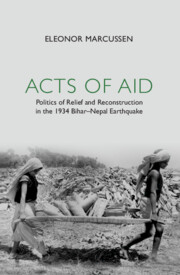Book contents
- Frontmatter
- Contents
- List of Illustrations
- List of Tables
- Acknowledgements
- List of Abbreviations
- Note on Transliteration
- 1 Introduction: Experiencing the Extraordinary and the Ordinary
- 2 Responses and Responsibilities in Emergency Relief
- 3 From Local to National Politics of Relief
- 4 Colonial Relations in Aid
- 5 Categories of Victims
- 6 Congested and Contested Spaces
- 7 Conclusion
- Glossary
- Bibliography
- Index
2 - Responses and Responsibilities in Emergency Relief
Published online by Cambridge University Press: 13 January 2023
- Frontmatter
- Contents
- List of Illustrations
- List of Tables
- Acknowledgements
- List of Abbreviations
- Note on Transliteration
- 1 Introduction: Experiencing the Extraordinary and the Ordinary
- 2 Responses and Responsibilities in Emergency Relief
- 3 From Local to National Politics of Relief
- 4 Colonial Relations in Aid
- 5 Categories of Victims
- 6 Congested and Contested Spaces
- 7 Conclusion
- Glossary
- Bibliography
- Index
Summary
Introduction: Disrupted Communication
The damages of sudden disasters often have a paralysing effect on local government structures and systems, and at the same time, a rapid response is essential to save lives and minimise damage. In this chapter, I discuss the local colonial government’s response in the immediate aftermath of the 1934 earthquake and the subsequent criticism of its inadequacy in responding to the needs of the disaster-stricken population. The government’s capacity and responsibilities in the aftermath revealed weak spots regarding preparedness for a major disruptive event: its security-oriented response reflected not only a fear of chaos as a possible springboard for adverse human behaviour but, perhaps more importantly, it revealed the importance of communication in maintaining control of the area. Even though the disrupted communication complicated relief and rescue work in practical terms, as discussed throughout this chapter, the central role of (disrupted) communication and (lack of) information in the government’s narrative of the aftermath reflected above all the importance of communication infrastructure to the local government.
The government’s response in the 1934 earthquake, S. N. Mukherjee describes, as slow and less occupied with clearing debris, saving lives and giving relief than in protecting and restoring government properties and factories. As he notes, such a security-oriented response may have been related to the Government of Bengal’s concurrent efforts to strike down what were perceived as increasingly violent nationalist groups, or a general apprehension towards nationalist political rivalry in the region. Taking notice of the administration’s priorities, Tirthankar Roy comments on the government’s response in the immediate aftermath: ‘Before saving lives, the civil administration had to guard the jails, the banks and the Treasury.’ As Roy notes, the government’s priority was one of the reasons for criticism of its relief effort in saving the lives of those injured by or buried under debris.
Mukherjee’s and Roy’s explanations of the local government’s security-oriented response and subsequent criticism by contemporary nationalists have support in the two conflicting master narratives of the earthquake aftermath. The government’s master narrative, A Report on the Bihar Earthquake, published by Relief Commissioner W. B. Brett, addresses every aspect of the earthquake’s aftermath in a dense summary account of damages and government action in 1934.
- Type
- Chapter
- Information
- Acts of AidPolitics of Relief and Reconstruction in the 1934 Bihar–Nepal Earthquake, pp. 49 - 96Publisher: Cambridge University PressPrint publication year: 2023
- Creative Commons
- This content is Open Access and distributed under the terms of the Creative Commons Attribution licence CC-BY-NC 4.0 https://creativecommons.org/cclicenses/



